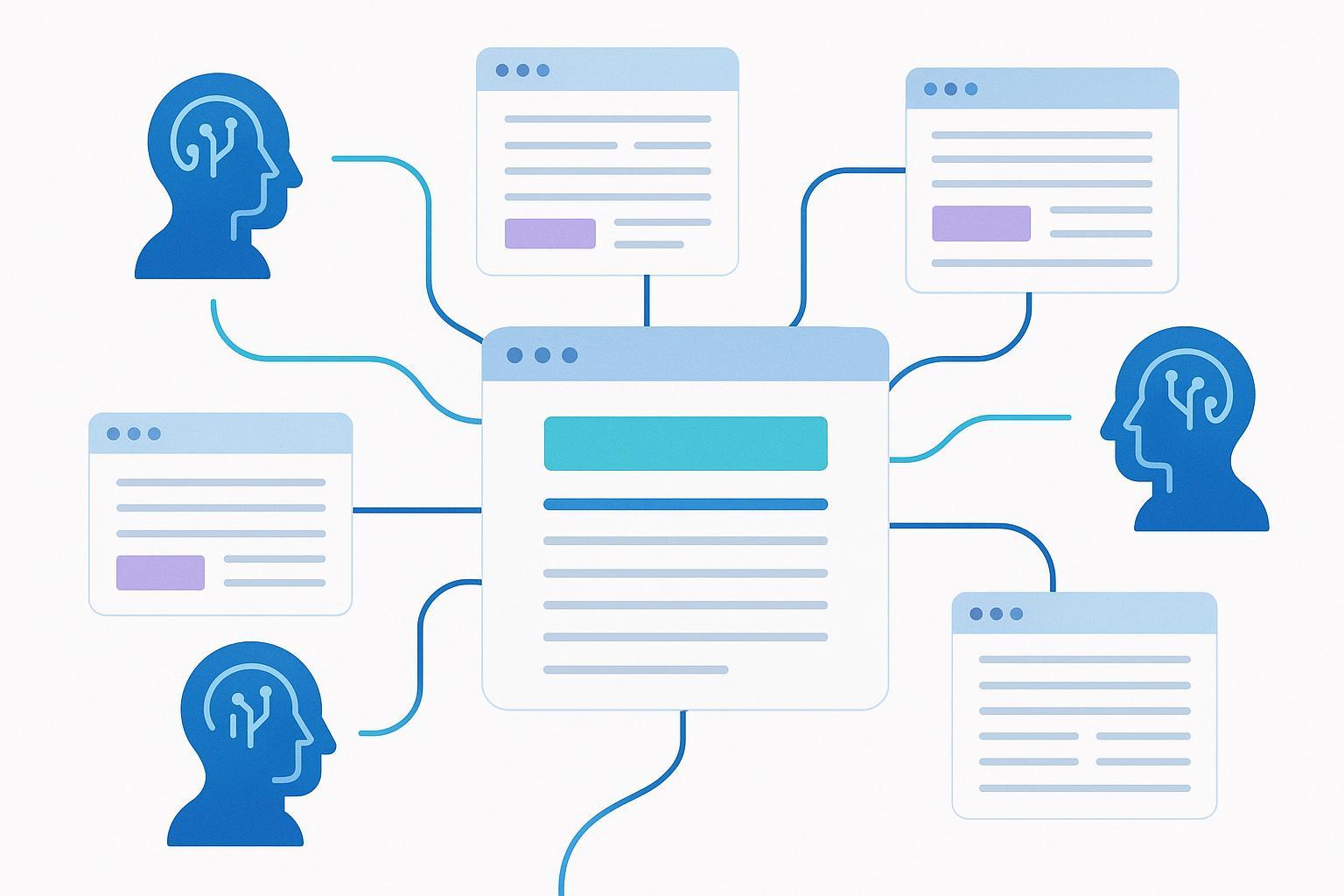Boost Productivity with a Research Paper Summarizer
Academic literature grows daily, creating mountains of content for scholars and students. Keeping up with this flood of information can be overwhelming when time is scarce.
A research paper summarizer can be your secret weapon. These tools use automatic summarization to turn complex academic content into clear overviews. You’ll get key insights without spending hours on each document.
Modern academic productivity tools do more than save time. They boost understanding and improve research efficiency. You’ll grasp findings faster and choose which texts need your full attention.
This guide explains summarization technology in detail. You’ll learn how to pick the right tools and use them well. Get ready to save time and excel in your academic work.
Key Takeaways
- Summarization tools help process large amounts of academic literature quickly
- Automatic technology extracts key insights while keeping the main meaning intact
- These solutions save time for deeper analysis and writing
- Focusing on condensed information improves understanding
- The right approach helps identify which full papers need thorough reading
- Modern tools are crucial for staying updated in fast-changing academic fields

Understanding the Importance of Summarization
Researchers face a big challenge: extracting knowledge from countless studies. Creating effective summaries is now crucial for academic success in every field.
Summarization turns information into useful insights. It helps you identify key messages quickly. This skill fuels research progress and boosts productivity.
Academics deal with huge amounts of info daily. The answer isn’t reading faster. It’s using smart summarization to work efficiently.
The Foundation of Research Excellence
Summarizing is how researchers process information. It’s not just shortening text. It’s critical analysis that deepens understanding.
This process helps you spot what’s important. You separate main ideas from details. You see strengths and limits in studies.
Effective researchers don’t just collect information—they synthesize it. This information synthesis connects different studies. You notice patterns across papers that single readings might miss.
Good summarization skills help your whole career. They lead to faster advancement and more publications. You can review literature more efficiently.
Summaries improve your literature review process. They save time by eliminating repeated paper readings. You can find specific findings quickly.
A database of summaries is a valuable resource. It lets you reference key studies easily. This knowledge gives you an edge in academic work.
Summarizing reveals gaps in research clearly. It helps you spot unanswered questions. These gaps often inspire new research ideas.
The skill improves overall critical thinking. It helps you spot flaws and assess evidence. You become better at evaluating information.
Literature review tools now support this key skill. Modern platforms offer features for efficient summarization. They help manage more scholarly articles without losing comprehension.
- Summarization Benefit
- Impact on Research Quality
- Time Efficiency Gain
- Long-term Value
- Enhanced comprehension
- Deeper understanding of core concepts and methodologies
- Reduces re-reading by 40-60%
- Builds cumulative knowledge base
- Improved retention
- Better recall of key findings during writing
- Decreases search time by 50%
- Creates reusable reference library
- Critical analysis skills
- Stronger evaluation of methodology and conclusions
- Speeds up paper selection by 35%
- Sharpens overall research judgment
- Pattern recognition
- Identifies research gaps and emerging trends
- Accelerates hypothesis formation by 45%
- Positions researcher as field expert
Good summarization boosts research productivity. Researchers who make quality summaries finish literature reviews 30-40% faster. This efficiency adds up over multiple projects.
Managing the Research Deluge
Information overload is a major research barrier. Academic databases have over 50 million papers. About 2.5 million new ones are added yearly.
This volume can cause decision paralysis. Researchers struggle to choose where to start. Some pick papers randomly or spend too long on initial readings.
Summarization tools provide a systematic solution to information overload. They generate quick overviews of many papers. You can scan literature efficiently without getting lost in details.
The approach shifts to strategic selection. Summaries help identify the most relevant papers. This ensures you focus on high-value sources for your research.
Modern researchers use a multi-stage approach. First, they quickly summarize potential sources. Then, they apply criteria to pick priorities. Finally, they read only the most relevant papers fully.
This method typically cuts reading time by 50-60%. It improves review quality too. You make informed choices about what to read deeply.
Research teams benefit greatly from summarization. Shared summaries help build collective knowledge faster. Everyone stays informed without duplicating efforts.
Research publication keeps growing rapidly. Fields like biomedicine and AI publish thousands of studies monthly. Effective knowledge extraction is crucial to stay current.
Literature review tools help track new trends. Automated summaries can monitor new publications. You get brief overviews of recent papers to spot breakthroughs quickly.
Building Blocks of Academic Communication
Summaries are crucial in academic writing. They serve multiple functions throughout the process. Every stage of scholarly writing benefits from well-made summaries.
Literature reviews rely heavily on summarization. Your ability to synthesize many sources depends on summary quality. Each summary becomes a building block for your argument.
Introductions often need context from prior research. Summaries provide this material quickly. You can reference relevant info without searching through full papers again.
Discussion sections compare your findings with previous studies. Good summaries make these comparisons more accurate. You have reliable records of what other researchers found.
Grant proposals need efficient summarization too. You must show literature knowledge while staying concise. Summaries help include key background without exceeding word limits.
Academic writing is fundamentally an exercise in selective synthesis. You choose what to include and how to present it. Summaries make these choices more informed.
Proper citations depend on understanding sources well. Thorough summaries reduce the risk of misrepresenting findings. This accuracy protects your reputation and strengthens arguments.
Teaching and mentoring also use summarization skills. Explaining complex research draws on summarized understanding. Clear explanations reflect good underlying summaries.
Conference talks need extreme info condensation. You might explain years of work in 15 minutes. Summarization skills help present your research effectively.
Interdisciplinary work demands strong summarization. You need to grasp concepts from unfamiliar fields. Summaries help you understand essentials without becoming an expert everywhere.
Revision becomes more efficient with good summaries. When reviewers ask for more sources, you can search your summary collection. You find relevant info without starting new searches.
Research teams need shared understanding. Summaries create a common knowledge base. When everyone uses the same paper summaries, discussions become more productive.
Summaries support cumulative academic knowledge. Each generation builds on previous work. Your summaries become foundations for future innovations. This intellectual progress depends on good summarization.
Features of an Effective Research Paper Summarizer
Top research paper summarizers have key features that boost productivity. These tools simplify your work, not complicate it. Let’s explore what makes exceptional summarizers stand out.
Accuracy and Quality of Summaries
Great summarizers produce accurate, high-quality summaries that represent the original research faithfully. They capture core methods, findings, and conclusions without distorting the author’s intent. This accuracy ensures you can trust the summary.
AI summarization technology has transformed how tools analyze academic texts. Advanced algorithms identify key concepts and relationships within research papers. These systems understand context and maintain the logical flow of arguments.
Quality summarizers cut redundant info while keeping critical nuances. They create coherent, readable summaries that synthesize information. The best tools also maintain proper attribution and indicate multiple perspectives.
“The value of a summary lies not in its brevity, but in its ability to preserve the essential truth of the original work while making it accessible.”
Look for tools with adjustable detail levels when evaluating AI summarization tech. You may need a brief overview or more comprehensive coverage. Flexibility in summary length ensures the tool adapts to your needs.
User-Friendly Interface
An intuitive interface makes a summarizer accessible and fits into your research routine. The best platforms prioritize simplicity without sacrificing functionality. Look for summarizers with straightforward upload processes that accept multiple file formats.
The interface should display your summary clearly with proper formatting. Visual clarity matters when processing multiple papers. Customization options like adjustable length and highlighted key terms enhance usability.
The learning curve should be minimal. You shouldn’t need extensive training to start generating quality summaries. Intuitive design lets you focus on research, not technical troubleshooting.
Integration with Research Tools
Effective summarizers connect with other tools in your research workflow. This connectivity makes them central to your research ecosystem. Citation management integration is one of the most valuable connections a summarizer can offer.
Leading tools also connect with note-taking apps and collaborative platforms. This facilitates knowledge sharing and speeds up collaborative research efforts. Consider how different summarizers fit your existing workflow before choosing one.
API access and export options extend integration possibilities. Cloud sync keeps summaries accessible across devices. This supports the mobile nature of modern research work.
How to Choose the Right Research Paper Summarizer
Choosing the right research paper summarizer can transform your work. A good tool saves time and enhances your research. A poor choice may leave you frustrated and overwhelmed.
Selecting a summarizer is like picking any crucial study aid. You need something reliable, efficient, and suited to your needs. Let’s explore more about how to make the best choice.
Key Considerations for Selection
Several factors should guide your decision when picking a summarization tool. These help ensure you choose tech that truly supports your work.
Document format compatibility is a crucial feature to check first. Some tools only handle PDFs, while others work with various formats. Ensure your chosen summarizer accepts the formats you use most.
Subject-area specialization is more important than many think. Some tools excel at scientific papers, using specific medical terminology. Others perform better with humanities or social sciences content.
Consider these essential selection criteria:
- Pricing models: Free versions, monthly subscriptions, annual plans, or one-time purchases each offer different value propositions
- Summary customization options: Length control, format preferences, and detail level adjustments
- Language support: Multilingual capabilities if you work with international research
- Processing speed: How quickly the tool generates summaries for time-sensitive projects
- Batch processing: Ability to summarize multiple documents simultaneously
- Export options: Formats for saving and sharing your summaries
Data privacy policies need special attention, especially for unpublished or sensitive research. Review how each tool handles your documents. Check if it stores data and who can access it.
Trial periods and demos offer chances to test before buying. Most quality tools provide a free trial. Use this time to process actual papers from your field.
Comparing Popular Summarizers – Research Paper Summarizer
Create an objective framework to evaluate options systematically. Focus on concrete capabilities rather than marketing claims.
Summarization tools fall into distinct categories. General-purpose summarizers work across all disciplines. Discipline-specific tools target fields like medicine or law with specialized vocabularies.
Browser extensions offer convenience for quick web research. Standalone apps provide robust features for serious work. Cloud platforms enable access from multiple devices.
Here’s a practical comparison framework:
- Feature Category
- Basic Tools
- Professional Tools
- Enterprise Solutions
- Document Types
- Text and PDF only
- Multiple formats including images
- All formats plus API integration
- Summary Quality
- Simple extraction
- Context-aware summaries
- AI-powered with learning capabilities
- Processing Speed
- 3-5 minutes per paper
- Under 1 minute per paper
- Instant with batch processing
- Collaboration Features
- None
- Basic sharing options
- Team workspaces and annotations
- Price Range
- Free to $10/month
- $20-50/month
- $100+/month or custom pricing
Consider your typical workflow when comparing options. Do you summarize five papers weekly or fifty? Will you work alone or share with teams?
The best tech adapts to your needs, not vice versa. Look for tools that blend smoothly with your existing study aids and platforms.
Reading User Reviews and Testimonials
User feedback reveals real-world insights that marketing materials don’t. Learning to evaluate reviews critically helps avoid common pitfalls.
Genuine reviews include specific details about use cases and experiences. They mention both pros and cons. Be wary of overly promotional or suspiciously similar reviews.
Look for patterns across multiple reviews. Repeated mentions of slow processing or poor service are likely real issues.
Not all negative feedback is equally important. Some complaints are deal-breakers, while others are minor:
- Deal-breakers: Consistent accuracy problems, data security breaches, inability to handle your document types, poor summarization quality in your field
- Minor issues: Slightly outdated interface design, occasional slow loading times, limited formatting options
- Subjective preferences: Color schemes, notification styles, or feature organization that don’t affect core functionality
Reviews from researchers in similar fields are especially valuable. Their experience offers more relevant insights than general feedback.
Academic librarians often provide excellent recommendations. They see which tools researchers use successfully. Don’t hesitate to ask for their input.
Check how recently reviews were posted. Software updates can change tool performance. A review from years ago may not reflect current capabilities.
Notice how companies respond to negative reviews. Responsive developers who address concerns show commitment to users. Silence in response to valid complaints is a red flag.
Benefits of Using a Research Paper Summarizer
Research paper summarizers offer powerful advantages for your research practice. These tools improve scholarly work in multiple ways. They save time, deepen understanding, and make a strong case for adoption.
Researchers who use summarization technology experience transformative changes. These tools have become essential for modern academic work.
Saving Hours on Literature Review
The most immediate benefit is a dramatic reduction in paper screening time. Research paper summarizers can cut initial paper evaluation time by up to 70%. This helps you quickly decide if a document needs your full attention.
Time savings become exponential when reviewing many papers for a literature review. A grad student can review summaries of 50 papers in 30-40 hours. This is much faster than the 100-150 hours needed without a summarizer.
This approach turns impossible deadlines into manageable timelines. You can focus your energy where it matters most. You won’t exhaust yourself on preliminary screening.
The compound effect of these time savings extends throughout your entire research project. You can now spend more time on analysis, writing, or experiments. Your productivity increases without sacrificing quality.
Improving Understanding Through Structured Summaries
Good summaries often enhance comprehension of complex material. Dense academic writing can obscure the core message. Summarization tools extract main ideas, providing clarity that full papers sometimes lack.
A two-stage reading approach maximizes efficiency and understanding. First, read the summary to grasp the paper’s main points. This creates a mental framework for the topic.
When you return to the full paper, you already understand its structure. This context allows you to engage more critically with detailed arguments. Your retention improves as new information connects to your existing framework.
Strengthening Team-Based Research
Summarizers effectively solve communication challenges in collaborative research. They help establish common understanding across different expertise areas. Summaries create a shared foundation efficiently.
Research meetings become more productive when everyone reviews the same summarized literature. Teams can dive directly into analysis and planning. This acceleration of collaborative research processes keeps projects moving forward.
Team members at all experience levels benefit from this approach. Junior researchers quickly orient to new topics. Senior researchers refresh their knowledge efficiently. Everyone contributes more effectively with the same informational baseline.
Distributed teams appreciate how summaries facilitate asynchronous collaboration. Time zone differences become less problematic. Team members can quickly review materials and provide feedback without scheduling conflicts.
Research paper summarizers create measurable improvements in academic productivity. They reshape how research teams operate. By saving time, improving comprehension, and facilitating collaboration, summarizers have become indispensable academic tools.
Best Practices for Using a Research Paper Summarizer
Research paper summarizers can deliver impressive results. But knowing how to use them effectively is key. This transforms good summaries into exceptional research assets.
These practices become natural habits that speed up your research process. They’re small investments that pay off in your academic work.
Preparing Your Documents for Optimal Results
The quality of your summary starts with how you prepare your input. Text-based PDFs and Word documents typically produce the best results. Scanned documents saved as images often cause problems.
Before uploading a paper, check if it’s text-based. Try selecting and copying text from the PDF. If you can’t highlight words, the file may need OCR processing first.
Think about which sections to include in your summarization. For most papers, you’ll want the intro, methods, results, and discussion. Long reference lists and appendices usually don’t add value to summaries.
For multi-chapter dissertations or book chapters, break them into logical segments. This improves efficiency by creating more focused summaries for each major section.
The secret to effective summarization isn’t just having the right tool—it’s knowing how to prepare your materials so the technology can work its magic.
For extensive literature reviews, batch processing is essential. Create a system to organize your materials. Name files consistently before uploading. Group papers by theme or research question.
Keep a tracking spreadsheet noting which papers you’ve summarized. Store summaries in dedicated folders that mirror your research structure. This prevents confusion when managing many papers at once.
The Essential Human Touch
Automated summaries should be starting points, not finished products. Even the best algorithms can miss context or oversimplify complex arguments. Human review is crucial for ensuring accuracy and usefulness.
You don’t need to reread the entire original paper. Instead, use focused quality checks to catch common issues. This respects your time while ensuring accuracy.
Use this checklist when reviewing summaries: Verify main findings. Check methodology description. Assess conclusion accuracy. Confirm limitations are noted. Review technical terms.
The review process depends on your intended use. Summaries for personal reference can be rough. Those for sharing need careful editing for clarity and precision.
Information synthesis requires your judgment about what matters most. Don’t hesitate to reorganize or rewrite sections to better serve your needs.
Remember, you’re not looking for perfection—you’re enhancing a helpful starting point. Most summaries need only minor adjustments to become valuable research tools.
Turning Summaries into Research Springboards
Summaries can do more than help you understand papers faster. They can be launching pads for deeper investigation. This approach multiplies the value of every summary you create.
Identify key citations mentioned in the summary. Create a list of these foundational sources to explore next. This helps you build backward through the research lineage.
Pay attention to methodological approaches described in summaries. If a paper used an innovative design, that method might work for your studies. Summaries help you spot promising methodologies without getting lost in statistical details.
Research gaps are golden opportunities. Authors often mention what remains unknown in their field. Noticing these gaps across summaries can identify areas ripe for new research.
Use summaries to generate focused research questions by looking for patterns. Watch for conflicting findings, underexplored populations, and methodological limitations. Also, spot emerging trends across recent publications.
Create an “insights document” to record observations as you review summaries. This becomes valuable as patterns emerge across your reading. You’ll start seeing connections between papers that weren’t obvious before.
For collaborative projects, summaries facilitate knowledge sharing among team members. This improves research efficiency while ensuring comprehensive coverage.
Effective researchers don’t just consume information—they actively transform summaries into questions, connections, and new research directions.
As these practices become routine, you’ll think more strategically about research papers. The summarization process trains you to identify what matters most. It helps you spot patterns and connect ideas from different sources.
The goal isn’t just reading faster. It’s thinking better about research and making smarter decisions about where to invest your time.
Future Trends in Research Paper Summarization
Research paper summarization is changing fast. New tech is transforming how scholars work with academic literature.
Advancements in AI Technology
AI summarization tech is improving quickly. Machine learning systems now grasp context better than before. These tools can tailor summaries to your knowledge level.
Neural networks for scientific text are more accurate in specialized fields. Future systems will combine multiple papers into overviews of entire research areas.
Potential Impact on Education and Research
Auto-summarization tools are changing academic work. They make scientific literature more accessible to wider audiences. Researchers can find connections across disciplines faster.
Graduate students can approach literature reviews with new methods. Summarizers help level the playing field for institutions with limited resources. Critical thinking is still key, but these tools handle routine tasks.
The Growing Need for Efficient Research Tools
Research publications are growing exponentially each year. Staying current across expanding fields is challenging. Summarization tools have become essential for productive researchers.
These systems boost human intelligence rather than replace it. They free up time for deep analysis and creative problem-solving. The future of research depends on smart tools that enhance your abilities.
FAQWhat exactly is a research paper summarizer?
A research paper summarizer is a specialized tool powered by AI. It reads academic papers and creates concise summaries. These tools highlight main findings, methods, and conclusions.Summarizers help researchers and students grasp key points quickly. They make literature reviews and research screening more efficient.
How accurate are automated research paper summarizers?
The accuracy of summarizers depends on their technology and specialization. High-quality AI summarizers can capture key findings and methodologies well. They often maintain the author’s intent accurately.It’s best to review any automated summary yourself. Always verify critical details against the original paper.
Can a summarizer replace actually reading the full research paper?
No, summarizers shouldn’t completely replace reading full papers. They’re great for initial reviews and staying current in your field. Use them to quickly find relevant studies.Important papers should still be read fully. This helps you catch nuances and understand context.
What types of documents can research paper summarizers process?
Most summarizers handle PDF files, the standard format for academic papers. Many also work with Word documents and web articles. Some can process entire document batches at once.Advanced tools offer browser extensions for summarizing papers from journal websites. Check your chosen summarizer’s capabilities before use.
Are research paper summarizers expensive?
Pricing varies widely for research paper summarizers. Some basic tools offer free versions with limited features. Mid-range options typically cost $10 to $30 monthly.Premium tools with specialized features cost more. Many providers offer free trials or demos.
How long does it take to generate a summary?
Most modern summarizers work fast, generating summaries in seconds to minutes. A standard 10-15 page research article usually summarizes in under 30 seconds.Batch processing takes longer but still saves time compared to manual reading.
Can I adjust the length of the summaries produced?
Many summarizers offer customizable summary lengths. You can choose brief overviews, moderate summaries, or detailed breakdowns. This flexibility lets you adapt the tool to your specific needs.Quick screening might need only brief summaries. In-depth literature reviews benefit from more comprehensive ones.
Do these tools work for papers in specialized scientific fields?
Yes, but effectiveness varies by field and tool. Some summarizers are general-purpose, while others specialize in specific areas. Specialized summarizers often perform better in their focus areas.They understand field-specific terms and conventions. For highly technical fields, look for tools with expertise in your domain.
Is my research data safe when using a summarizer?
Data privacy policies vary between summarization tools. Always review terms of service before uploading sensitive research. Reputable tools typically don’t store documents permanently.For confidential material, look for summarizers with data privacy guarantees. Some offer on-device processing or enhanced security features.
Can summarizers handle papers in languages other than English?
Many modern summarizers support multiple languages. English papers typically get the most accurate results. Some tools support major languages like Spanish, French, and Chinese.If you work with non-English research, verify language support before choosing a summarizer.
How do summarizers integrate with reference managers like Zotero or Mendeley?
Integration capabilities vary by tool. Some summarizers offer direct plugins for popular reference managers. These allow you to summarize papers from your library and save summaries with references.Others might require manual export and import. Choose a summarizer that supports your preferred reference manager.
Will using a summarizer help me write better literature reviews?
Absolutely! Summarizers can greatly improve your literature review process. They help identify relevant studies and extract key findings quickly. You can screen more papers in less time.However, the best reviews still need your critical analysis. Use summarizers for extraction, then focus on higher-level thinking.
Can I use summarizer output directly in my academic writing?
Never copy summarizer output directly into your writing without revision and attribution. Summaries are starting points, not ready-made content. Always read the original source and verify points.Paraphrase information in your own words. Cite the original research, not the summarizer.
What’s the difference between a research paper summarizer and a general text summarizer?
Research paper summarizers are designed for academic writing. They understand scientific terms and research methods. They recognize important sections like abstracts, methods, and results.General text summarizers often miss critical details in academic papers. They’re not trained on scientific literature.
Can these tools summarize an entire dissertation or thesis?
Summarizing entire dissertations is challenging due to length and complexity. Most summarizers work best with individual papers or chapters. For long documents, summarize chapters separately.Some advanced tools can handle longer works by breaking them into sections.
How are AI-powered summarizers different from simple extraction tools?
AI summarizers use language processing to understand content. They identify key concepts and generate new sentences. Simple extraction tools just pull out existing sentences based on keywords.Advanced AI can paraphrase and synthesize information. This creates more readable and useful summaries.
What should I do if a summary seems to miss important information?
First, check your settings. You might need a more detailed summary option. Try adjusting the summary length or detail level.If problems persist, remember no tool is perfect. Complex papers may challenge even the best summarizers. Use the summary as a starting point.
Can research paper summarizers help with collaborative projects?
Yes! Summarizers create quick, common understanding across team members. They make research meetings more productive. Team members with different expertise can contribute more effectively.Some summarizers offer sharing features for team libraries of summarized research.
Are there discipline-specific summarizers for fields like medicine or engineering?
Yes, several summarizers specialize in particular academic disciplines. Medical research has tools trained on PubMed literature. They understand clinical terms and study types.Computer science and engineering have optimized tools too. These specialized summarizers often outperform general-purpose ones in their fields.
How will future AI advancements improve research paper summarizers?
Future AI promises exciting improvements for summarizers. We’re moving towards context-aware summarization that adapts to your knowledge level. Multi-document synthesis could summarize entire research topics.Soon, we might see personalized summaries highlighting aspects most relevant to your research questions. AI could identify contradictory findings and suggest promising research directions.








